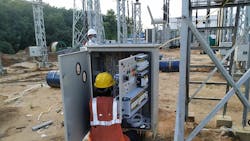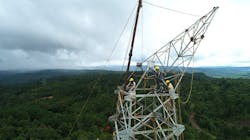A Mega Interstate Transmission Project Powers Northeast India
With growing demand, stronger interconnections were needed in the Northeastern region of India to the national power grid. The Ministry of Power’s answer to this need was interstate transmission project NER-II. Spanning the states of Assam, Arunachal Pradesh and Tripuras, this mega-power transmission project enabled access to a reliable and secure supply of electrical energy for some 53 million people living in the region.
The Ministry of Power awarded the contract for this project to Sterlite Power Transmission Ltd. in March 2017 for a 35-year period from the scheduled commercial operation date on a build-own-operate-maintain (BOOM) basis. The project was sold to Indigrid, India’s first and largest power-sector infrastructure investment trust (InvIT) at an enterprise value of INR 4625 crore (US$600 million) after commissioning in March 2021.
Key Elements
The NER-II project was designed to transmit more than 3000 MW to the Northeastern region of India. In addition to strengthening the grid, this project was designed to play a vital role in enabling access to a reliable source of power for the region. This interstate transmission system includes 11 elements, including two substations with a combined transformer capacity of 1250 MVA and four transmission lines supported by 1008 towers over a distance of approximately 830 circuit km (516 circuit miles).
The key elements of this project and their importance were as follows:
- 178-km (111-mile), 400-kV double-circuit, quad-conductored Silchar-Misa transmission line with aluminum conductor steel-reinforced (ACSR) Moose conductor having an overall diameter of 31.77 mm (1.25 inches). This line provides a strong interconnection between the northern and southern parts of the Northeastern region, facilitating the dispersal of power from central, private generation projects to various parts of the region through the formation of a 400-kV Silchar-Misa-Balipur-Bongaigaon-Azara-Bymihat-Silchar ring network. Further, this transmission line provides an additional circuit beyond Silchar for the evacuation of power from the Palatana gas-based power plant.
- 132-kV double-circuit Biswanath Chariyali-Itanagar transmission line with ACSR Panther conductor having an overall diameter of 28.62 mm (1.13 inches). This transmission line strengthens the interconnections between Assam and Arunachal Pradesh by providing an additional source of power for the city of Itanagar.
132-kV double-circuit transmission line between the Agartala gas turbine power plant (AGTPP) owned by the North East Electric Power Corp. (NEEPCO) and PK Bari was upgraded with high-temperature, low-sag (HTLS) conductor having a diameter of 18.06 mm (0.711 inches). This 84-km (52-mile) transmission line was planned
for the reliable evacuation of power from the AGTPP generation power plant, which has an installed generation capacity of 135 MW. - 400-kV Surajmaninagar-PK Bari double-circuit transmission line with ACSR Moose conductor having an overall diameter of 31.77 mm (1.25 inches). This is 77-km
(48-mile) transmission line provides an additional 400-kV corridor to enable reliable power evacuation from the Pallatana gas turbine power plant. - Two 400/132-kV greenfield substations — each equipped with two sets of three single-phase 105-MVA, 400/132-kV transformers — providing transformation capacity of 315 MVA each, for a total of 630 MVA. One single-phase 105-MVA transformer is supplied as a spare unit. The substations are located at Surajmaninagar and PK Bari in the state of Tripura. Each substation has sufficient space to install one additional set of three single-phase 105-MVA, 400/132-kV transformers, for additional future capacity of 315 MVA. This element of the overall project was subject to an engineering, procurement and construction (EPC) contract undertaken in partnership with General Electric.
This project was designed to be a carrier of clean energy, as it effectively connects various sources of hydro and gas-fired sources of installed generation to the national grid. With gas acting as a natural balancer for renewable generation, the evacuation of gas-fired sources of power generation through the 400/132-kV substation at PK Bari in Tripura and the associated interconnections play an important role in reducing the intermittency of generation from renewable energy sources.
Construction Challenges
The Northeastern region of India includes mountains, valleys and hills as well as an undulating tough terrain prone to inclement weather conditions. Conducting the initial survey was an arduous task. Monsoon season in this region can last for five months, during which the rainfall has been recorded as being among the highest in the world. During the construction phase of this project, it rained incessantly for seven months to eight months a year, which left a noticeably short season of dry weather for actual construction to take place. Also, as this region is an active seismic zone, the entire transmission corridor had to be designed and constructed to withstand seismic activities and variable wind speeds.
Multiple challenges arose because of the varying altitudes and treacherous terrain. To transport materials to some tower foundations, access roads had to be built. Soft soil and high water tables also increased the complexity of the project. Soil data was collected at critical locations and tailor-made foundations were designed for them. In Borgang and Gogpur in Assam, this issue was tackled by adopting a unique methodology involving combined raft foundation footings, which helped to avoid
additional cost and keep the project on schedule.
Overall, the nature of the terrain through which the transmission lines had to pass made the route surveys extremely tedious, but the experience of the Sterlite Power surveyors helped to minimize the challenges. Also, all overhead transmission line construction work was planned to ensure on-site works were minimally affected during the monsoon months.
The project also faced severe rights-of way (RO) challenges, as significant sections of the overhead transmission lines passed through areas with high tribal populations and autonomous councils. For example, 50% of the 400-kV Silchar-Misa overhead transmission line in Assam came under the purview of the autonomous councils in the region.
Then, in 2020, the project was severely disrupted by the COVID-19 pandemic, which led to a strict nationwide lockdown. Significant work restrictions were in place. This coincided with the need to move thousands of tons of overhead line materials to the challenging locations. At the time, it was estimated it would take some 1500 workers to move the materials manually in the hilly terrain — a task that would have taken a full year and increased the risk of COVID-19 infection.
To speed up construction, Sterlite Power implemented an extensive aerial operation by deploying lightweight helicopters to transport 6700 metric tons (7385 tons) of material across 50 locations in Assam and Arunachal Pradesh. This modification made the transportation of construction material safer, quicker and more efficient.
Community-Based Approach
Sterlite Power places a strong emphasis on taking a community-based approach in all its projects. Creating positive social impact is one of its core values. In line with this philosophy, the company engaged with various communities, including autonomous tribes such as Biates, Hmar, Dimasa, Zeme and Karbi across 200 villages, to ensure an inclusive approach toward development.
Employment was provided to more than 10,000 skilled and unskilled people during the construction phase of the project. Concerted efforts were made to provide essential health care to vulnerable communities around the project sites during the pandemic and national lockdown. Apart from providing relief items, the company carried out multiple job training and skills programs with underprivileged communities.
Project Achievements
The project kicked off in March 2017 and estimated completion dates for the different system elements ranged from 36 months to 44 months. Despite all the challenges during the three-year project period, all elements were commissioned from February 2021 to April 2021.
In addition to providing reliable supply of power to the region, this project was a true harbinger of sustainable development. Apart from enhancing the reliability and availability of the power supply, the project has the potential to boost the annual per-capita electricity consumption in the Northeastern region from 402 kWh today to the national average of 1208 kWh.
With the successful commissioning and completion of the mega NER-II project, more than 3000 MW of power is now delivered to the people in Northeastern India. The most difficult and treacherous terrain had to be overcome to build this crucial power corridor with the help of innovative technologies. Throughout the entire project, the utmost care was taken to ensure the least impact to the region’s pristine environment.
About the Author
Manish Agarwal
Manish Agarwal ([email protected]) is a Harvard alumnus and also holds a degree in engineering. His 25-year career started in telecoms, leading the company to become a market leader in India and international markets before joining Sterlite Power. Currently, he is Sterlite Power’s CEO, responsible for Infrastructure and engineering, procurement and construction services as well as the power products business. Agarwal is credited with transforming the way electrical infrastructure, both greenfield and brownfield, is built in India. He is a leading voice on key industry issues, shaping policy priorities on trade and sustainability, and an advocate of modern and innovative technology. He is chairman of the task force on transmission at the Associated Chambers of Commerce and Industry of India, vice president of CIGRE India, a member of the National Executive Council of IEEMA, a member of the Federation of India Chambers of Commerce and Industry power committee and vice president of the Cable and Conductor Manufacturers Association of India.
Arun Sharma
Arun Sharma ( [email protected]) is chief projects officer of the infrastructure and solutions business at Sterlite Power Transmission Ltd. An accomplished leader in the energy sector, Sharma brings three decades of rich leadership experience in strategy and execution of large-scale engineering, procurement and construction (EPC) projects in India, Southeast Asia and CIS countries. He has in-depth experience across nuclear, coal-based, combined cycle power plants, liquefied natural gas, and oil and gas. In the oil and gas industry, Sharma gained strong experience in the EPC of refinery, outfield well pads, metering stations, sulfur recovery, cross-country pipeline units and gas treatment units. Prior to joining Sterlite Power, he served in leadership positions with organizations like Nuclear Power Corp. of India, Enron India, KazStroy Service and Punj Lloyd.




